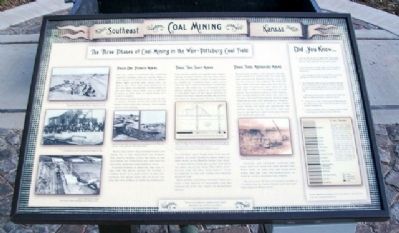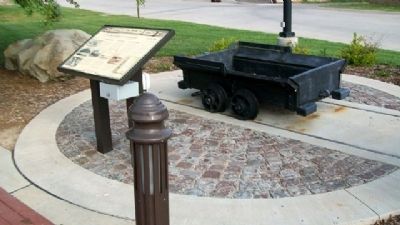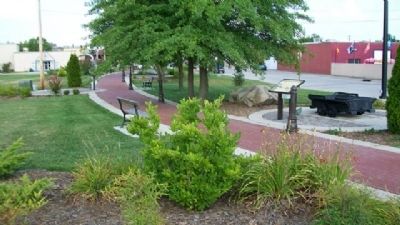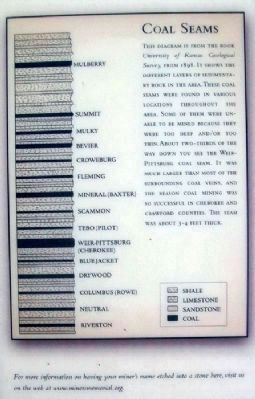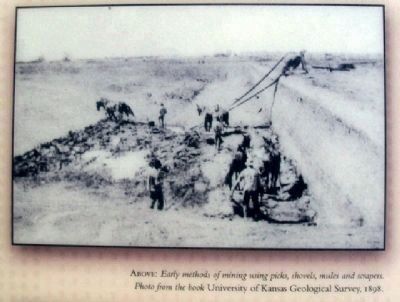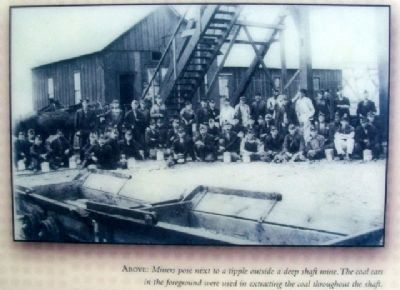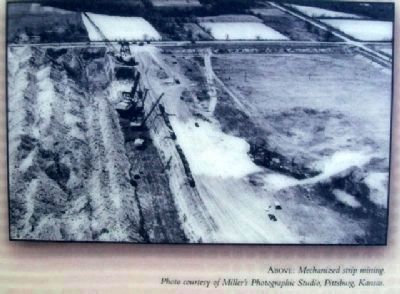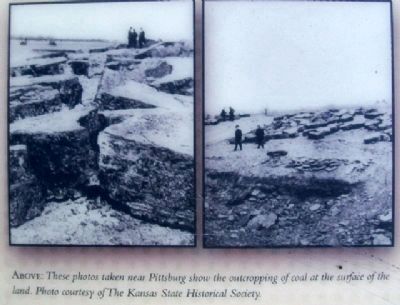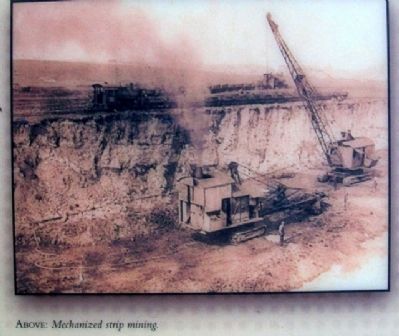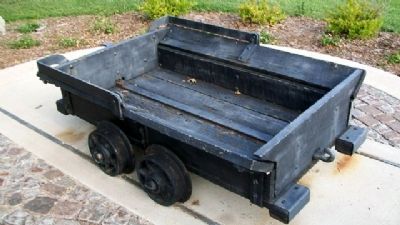Pittsburg in Crawford County, Kansas — The American Midwest (Upper Plains)
Southeast Kansas Coal Mining
The Three Phases of Coal Mining in the Weir-Pittsburg Coal Field
— Miners' Memorial at Immigrant Park —
Phase One: Pioneer Mining
The coal fields of Cherokee and Crawford Counties covered over 300 square miles of land, making it a prime area for coal mining. When early settlers first moved into the area in the 1800's, they were amazed to see the coal seams outcropping at the surface of the land. They could easily pick up the coal by hand to bring back to their homes as a source of energy.
Because of its shallowness, the coal was easy to remove. Pioneer mining was done on the surface with picks and shovels, mule-drawn wagons, and scrapers.
Early strip mining was unsophisticated and crude, but it was productive for workers. They mostly worked along the parts of the seam where the overburden was very shallow and easily removed with primitive tools.
Another method of removing the coal at this time was ravine mining. By digging a "gopher hole" at a right angle to the outcropping, the miners were able to access the coal bed and extract it from the depression.
Phase Two: Shaft Mining
Soon pioneer mining led the way into underground or shaft mining. The first mine shaft was sunk in Cherokee County in 1894 outside of present-day Scammon. Three years later, the first shaft mine in Crawford County was sunk on the town-site of Pittsburg. Shaft mining enabled the miners to go deeper and to mine more than did the earlier methods of extraction. Shaft mining became the distinctive mode of mining from the late 1870's until the early 1930's. There were over 290 important or fairly important mines, nearly all shaft mines, in the Weir-Pittsburg coal field.
In shaft mining there was a structure above the mine called the tipple. The tipple hoisted coal from the shaft. From there it could be screened by size and loaded into waiting railroad cars.
Shaft mining continued for many years, but soon a new method of excavating coal was introduced with the advent of mechanized shovels.
Phase Three: Mechanized Mining
Mechanized mining soon became the preferred method of mining the coal from this area because the Weir-Pittsburg coal vein ran so close to the surface. To mine the coal, large electric draglines and shovels were used to excavate long strips of the land. This is why it is referred to as strip mining. The machines removed the overburden on the surface and made the coal accessible. The machines would remove some strips miles long, and the removed overburden created huge piles next to the mined strips. After one strip was exhausted, the miners moved on to the next strip and filled the previous strip with the overburden from the new one.
Cherokee and Crawford counties have many deep pits from the strip mining days. Today many of these pits are filled with water and are used for recreational activities such as boating and fishing.
Information from The Historical Geography of the impact of Coal Mining upon the Cherokee-Crawford Coal Field of Southeastern Kansas by William Powell.
Did You Know...
• ...coal cars, like the one on display here, were mostly used in shaft mining. Hundreds of coal cars lined tracks under the surface, pulled for the most part by mules.
• ...native Americans and early settlers in the area, picked up the coal that outcropped at the surface to burn in their homes.
• ...coal outcropped east of a line from Weir to Pittsburg, giving it the name the Weir-Pittsburg Coal Field.
• ...the sedimentary layers of rock and mineral under the surface of Cherokee and Crawford counties is arranged in a gentle incline, dipping down in a north and west direction and getting approximately 20 feet deeper per mile.
• ...early miners used to take a canary into the mine with them as a safety precaution to check for bad air.
• ...miners had to work on their hands and knees because the ceilings in the mines weren't tall enough to accomodate a standing man.
• ...miners sometimes went to a mining school to learn the operating and safety procedures of the job.
Coal Seams
This diagram is from
the book University of Kansas Geological Survey, from 1898. It shows the different layers of sedimentary rock in the area. These coal seams were found in various locations throughout the area. Some of them were unable to be mined because they were too deep and/or too thin. About two-thirds of the way down you see the Weir-Pittsburg coal seam. It was much larger than most of the surrounding coal veins, and the reason coal mining was so successful in Cherokee and Crawford counties. The seam was about 3-4 feet thick.
The coal car on display was constructed using the original wheels from a mine car. This car was rebuilt by Louis Casaletto & Primo Guerrieri.
Erected 2008 by Miners' Memorial.
Topics. This historical marker is listed in these topic lists: Civil Rights • Industry & Commerce • Labor Unions • Settlements & Settlers. A significant historical year for this entry is 1894.
Location. 37° 24.552′ N, 94° 42.439′ W. Marker is in Pittsburg, Kansas, in Crawford County. Marker is at the intersection of West 2nd Street and Walnut Street, on the right when traveling west on West 2nd Street. Marker is at the Miners' Memorial. Touch for map. Marker is in this post office area: Pittsburg KS 66762, United States of America. Touch for directions.
Other nearby markers. At least 8 other markers are within walking distance of this marker. Frontenac, Kansas (a few steps from this marker); The Weir - Pittsburg Coalfield (a few steps from this marker); The Weir-Pittsburg Coal Field in Cherokee County (within shouting distance of this marker); Wilkinson Coal Company (within shouting distance of this marker); Alexander Howat (within shouting distance of this marker); The Amazon Army (within shouting distance of this marker); Immigrant Park (about 400 feet away, measured in a direct line); The Freedom Tree (approx. ¼ mile away). Touch for a list and map of all markers in Pittsburg.
Also see . . .
1. Miners' Memorial. (Submitted on September 11, 2010, by William Fischer, Jr. of Scranton, Pennsylvania.)
2. Former Mining Communities ... of SE Kansas. (Submitted on September 11, 2010, by William Fischer, Jr. of Scranton, Pennsylvania.)
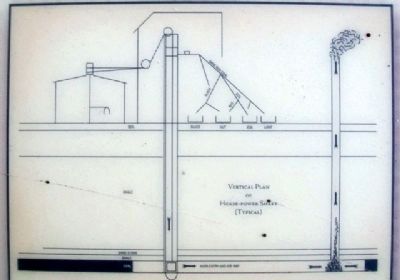
undated
9. Photo on SE Kansas Coal Mining Marker
[Caption reads] This diagram shows an early shaft mine. Coal is sorted at the top of the tipple and distributed into different railroad cars. This diagram also shows one method of ventilating the mine using a furnace to push out bad air and pull in clean air.
Credits. This page was last revised on December 9, 2021. It was originally submitted on September 11, 2010, by William Fischer, Jr. of Scranton, Pennsylvania. This page has been viewed 3,338 times since then and 44 times this year. Photos: 1, 2, 3, 4, 5, 6, 7, 8, 9, 10, 11. submitted on September 11, 2010, by William Fischer, Jr. of Scranton, Pennsylvania.
